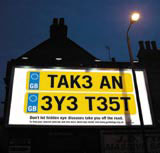RCA and industry unveil socially responsible work

Collective reluctance to get our eyes tested and the inadequacy of home office furniture are among the social issues explored in a series of industry-funded projects unveiled at London’s Royal College of Art last week.
The symposium saw 12 research associates – all RCA design graduates – presenting the findings of ten year-long projects, each of which explored a socially inclusive design scenario in one of four categories: health, home, work or urban space.
Some, such as Harriet Harriss and Suzi Winstanley’s ‘knowledge interactions and the older worker’, sponsored by DEGW, Ideo and Steelcase, are ongoing. Others have already been adopted by the organisations that supported them.
Gero Grundmann’s proposal for an ambient, media-driven campaign to encourage over-45s to have their eyes checked is likely to be rolled out formally by Guide Dogs for the Blind.
Likewise, a desk developed as part of Peter Fullagar and Dan Jones’ ‘rethinking of office furniture’ project, is being put into production by industry partner Dams International for the US and European markets.
The work is the product of the fifth annual wave of research associates co-ordinated by the RCA’s Helen Hamlyn Research Centre, in a programme that draws on graduates from the full range of design disciplines, from vehicle design to architecture and interiors.
‘There is a big range of disciplines and there is a big range of outcomes, from design tools to new bits of thinking to real products,’ says Jeremy Myerson, professor of design studies and co-director of the HHRC.
Each of the projects is initiated and partly funded by an external partner, which submits a brief to the HHRC, helps select an appropriate applicant from the RCA’s graduate classes and then participates in the development process.
Third parties involved this year included electronics giant Philips, mobile phone operator Orange and pharmaceuticals company GlaxoSmithKline. The HHRC itself provides the rest of the funding and manages the programme. The results are on exhibit to the public at the RCA in London’s Kensington Gore this week.
Previous success stories include a range of easy-to-use power tools developed by Matthew White in consultation with B&Q, which was added to the DIY chain’s product range and continues to sell.
‘The aim of it is to get new RCA graduates together with industry partners, some of which are commercial partners and some of which are voluntary sector organisations,’ says Myerson.
‘It is not intended as a rival consultancy to the design business. It is what we call applied design research – looking at those areas commercial designers have not got time to look at in the day-to-day.’
The sixth wave of research associates begins work on projects for sponsors including MFI, the Audi Design Foundation and the National Patient Safety Agency later this month.
-
Post a comment



